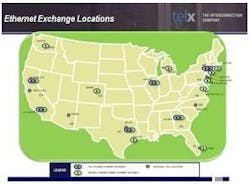Telx opens Ethernet exchange
JUNE 3, 2010 -- Interconnection and co-location provider Telx has debuted the Telx Ethernet Exchange, a new capability designed to help service providers and enterprises to seamlessly interconnect their Ethernet networks, providing greater reach to their end customers.
The Telx Ethernet Exchange platform, enabled by Cisco router and software management technology, is an easier way to connect buyers and sellers of Ethernet services, according to the company. Service providers can connect their Ethernet networks without setting up individual, complex interconnection agreements or building out local fiber networks.
"Business Ethernet is the fastest growing strategic data offering for service providers, growing at a compound rate of 24 percent per year over the next five years," said Rosemary Cochran, principal, Vertical Systems Group. "The rapid growth of mobile backhaul, video, virtualization, and other mission-critical applications is fueling the demand for scalable, high-bandwidth, and low-latency Ethernet connectivity from metro areas to broader geographies. Telx's Ethernet Exchange service is well-positioned to help expand the market."
To expand the reach of service providers' networks, Telx Ethernet Exchange will become available in seven strategic interconnection data centers over the next nine months with initial customers being part of a charter program in the third quarter of 2010. Service providers and enterprises will also receive professional consultation services to help ensure full Ethernet interoperability.
The Telx Ethernet Exchange is powered by Cisco ASR 9000 Series Aggregation Services Routers and Cisco Active Network Abstraction network management software. Using an automated customer portal, Telx says, the Telx Ethernet Exchange enables users to rapidly establish new virtual connections in minutes and leverage robust reporting, which allows customers to see inventory and metrics to help run their business.
"Telx leads the market in providing interconnection services in the most strategic and carrier-dense data centers in the U.S., so expanding our portfolio to include Ethernet Virtual Connections is a natural evolution. The Telx Ethernet Exchange is a direct response to the needs within our global marketplace of customers, who have been limited to offering and supporting Ethernet services in markets where they have services deployed," said Eric Shepcaro, CEO of Telx. "Telx can now facilitate customers extending their Ethernet network reach, and being powered by the Cisco platform ensures we will provide a high-performance and feature-rich service to meet their needs."
The Telx Ethernet Exchange will be available in its two New York City locations, 111 8th Avenue and 60 Hudson Street, along with its Atlanta and San Francisco facilities. There are plans to roll out capabilities in remaining locations in the coming months.
Visit Telx
Visit Cisco
